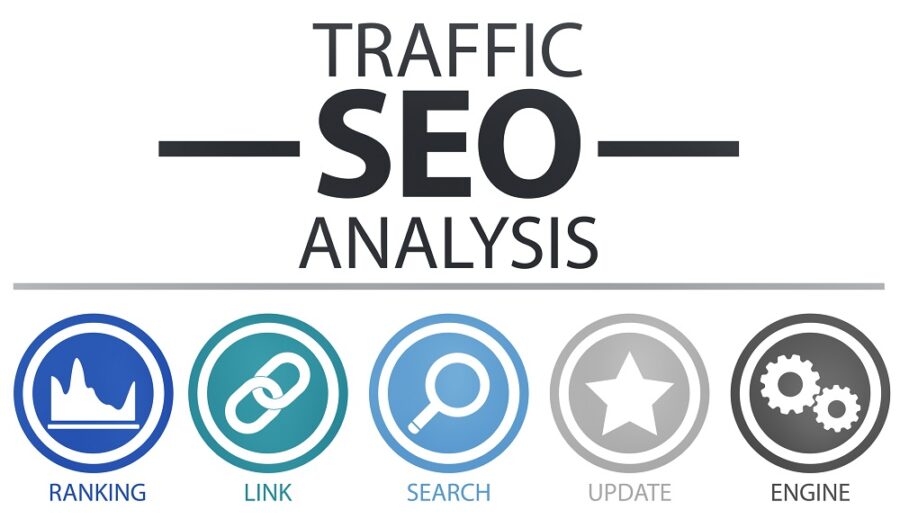Welcome to our complete overview about SEO for your website. Your may wonder why SEO? What is SEO for your website? Or even were searching for how to do SEO for website step by step? Maybe also what should I put for SEO on my website? How does SEO work? Or even what is SEO and what does SEO mean? We will give you here a full on answer to SEO, the search engine optimization. We will also see what are the 5 important concepts of SEO. Read on to understand.
First, what is SEO?
Search engine optimization (SEO) is the process of improving the ranking of a website on search engines like Google. The higher a website ranks, the more likely people are to click on it and visit it. There are many different factors that can impact a website’s ranking, including the quality and relevance of its content, the number and quality of links from other websites, and the use of keywords. By optimizing a website for search engines, it is possible to increase the amount of organic traffic the website receives, which can lead to more sales or leads for the business.
Overview about SEO
1. How to do on-page SEO
On-page search engine optimization (SEO) refers to the techniques used to optimize the content and structure of a website to improve its ranking on search engines. Here are a few examples of on-page SEO techniques:
- Use of keywords:
- Including relevant keywords in the title tags, meta descriptions, and throughout the body of your website’s content can help search engines understand what your site is about and improve its ranking.
- Title tags:
- The title tag is the text that appears in the browser tab when someone visits your website.
- Make sure that your title tags accurately reflect the content of each page on your site and include relevant keywords.
- Meta descriptions:
- Meta descriptions are short summaries of a web page’s content that appear under the title tag in search engine results.
- Make sure that your meta descriptions are concise and include relevant keywords.
- Headings:
- Organize your content into headings (H1, H2, H3, etc.) and use keywords in the headings where relevant.
- Content quality:
- Make sure that your website’s content is high quality, informative, and relevant to your target audience.
- Search engines favor sites with useful and informative content over those with low-quality or spammy content.
- URL structure:
- Use clear and descriptive URLs that reflect the structure of your website.
- Avoid using complex strings of numbers and letters in your URLs.
- Images optimization:
- Optimize images by using descriptive file names, compressing them, and using alt tags to describe the images.
- Site speed:
- Make sure that your website loads quickly, as search engines take page load time into account when ranking sites.
- Mobile friendly:
- Make sure your website is mobile-friendly, as more and more searches are being done on mobile devices.
It’s worth noting that SEO is a long-term effort and often it could take some time before you start seeing the results, keep on monitoring your website’s analytics and keep doing the optimization work.
2. How to do off-page SEO
There are many different strategies that can be used for off-page search engine optimization. Here are a few examples:
- Link building:
- One of the most important factors for ranking well in search engines is the number and quality of links pointing to your website.
- You can build links by creating high-quality content and promoting it on social media and other websites.
- Influencer outreach:
- Connecting with influencers in your industry can be a powerful way to promote your website and build links.
- You can reach out to influencers through social media or email and ask them to share your content or link to your website.
- Guest blogging:
- Writing articles for other websites in your industry is a great way to build links and increase your visibility.
- Just make sure the websites you guest blog for are reputable and have a high domain authority.
- Social media marketing:
- Promoting your content and website on social media platforms can help increase traffic and build links.
- Local citations:
- If you have a local business, getting listed on local business directories and websites can help improve your search engine ranking.
- Review management:
- Encouraging customers to leave reviews of your business on sites like Google My Business and Yelp can help improve your local search ranking.
3. How to do technical SEO
Technical search engine optimization (SEO) refers to the behind-the-scenes techniques used to improve a website’s ranking on search engines. Here are a few examples of technical SEO techniques:
- Crawling and indexing:
- Make sure that search engines can easily crawl and index your website by creating a sitemap and submitting it to search engines. Also, submit your website to Google Search Console.
- Robots.txt file:
- Use a robots.txt file to prevent search engines from crawling parts of your website that you don’t want indexed.
- 301 redirects:
- If you’ve changed the URL of a page on your website, set up a 301 redirect from the old URL to the new URL to make sure that visitors and search engines are directed to the correct page.
- Canonical tags:
- Use canonical tags to specify the preferred version of a web page when there are multiple pages with similar content on your site.
- SSL/HTTPS:
- Make sure your website uses a secure SSL/HTTPS connection to encrypt data transferred between the site and its visitors.
- This can increase the trust and credibility of your website, and it can also impact its ranking on search engines.
- Site structure:
- Make sure that your website’s structure is easy to navigate, with a clear hierarchy of pages and a logical organization of content.
- XML sitemap:
- Create and submit a XML sitemap to search engines to help them better understand the structure of your website and its pages.
- Page speed:
- Optimize your website’s page load speed by compressing images, minifying code, and reducing the number of requests made by the browser.
- Microdata and Schema markup:
- Use Microdata and Schema markup to provide search engines with more information about your website’s content, such as reviews, products, and events.
- AMP (Accelerated Mobile Pages):
- AMP is a Google-backed project that can speed up your website for mobile devices.
- This can help improve the user experience and increase your chances of appearing in Google’s “Top Stories” carousel.
These are just a few examples of the many technical SEO techniques that can be used to improve a website’s search engine ranking. It’s important to regularly audit your website to catch any technical issues that might be holding you back in the search results.

4. What is SEO in digital marketing?
SEO, or search engine optimization, is a subset of digital marketing that focuses on improving a website’s visibility and ranking on search engine results pages (SERPs). The goal of SEO is to increase the quantity and quality of organic traffic to a website from search engines like Google, Bing, and Yahoo.
SEO is a complex process that includes a number of different tactics and techniques, including:
- Keyword research:
- Identifying the keywords and phrases that potential customers are using to search for products or services like yours. See how successful keyword research works.
- On-page optimization:
- Optimizing the content and structure of a website to make it more attractive to search engines. This can include things like meta tags, header tags, and keyword-rich content.
- Off-page optimization:
- Building links from other websites to your website.
- The number and quality of links pointing to your site can impact your search engine ranking.
- Technical SEO:
- Optimizing the underlying technology of a website to make it more accessible to search engines.
- This can include things like site speed, mobile optimization, and crawlability.
- Local SEO:
- Optimizing for local search by claiming your business on local directories, creating local content, and building local backlinks.
In short, what is SEO and how it works?
Search engines use complex algorithms to determine which websites should appear at the top of SERPs. These algorithms take into account hundreds of different ranking factors or signals, and SEO is all about understanding these ranking factors and making the necessary changes to your website so that it ranks higher in search results. It’s worth noting that SEO is a continuous process and search engines regularly updates their algorithms, so SEO efforts need to be updated accordingly to maintain and improve the ranking. Also see for organic marketing strategies.
5. Organic marketing strategies
Organic marketing is a type of marketing that focuses on growing a business naturally, without the use of paid advertising. The goal of organic marketing is to attract and engage an audience through relevant, high-quality content and positive customer experiences.
Here are a few examples of organic marketing strategies:
- Content Marketing:
- Creating and distributing valuable, relevant, and consistent content to attract and engage a specific target audience.
- This can include blog posts, videos, infographics, social media posts, and more.
- Search Engine Optimization (SEO):
- Optimizing your website and its content for search engines so that it ranks well in search engine results pages (SERPs) for relevant keywords.
- This can include techniques like keyword research, meta tags, link building, and more.
- Social Media Marketing:
- Using social media platforms to connect with and engage customers, increase brand awareness, and drive traffic to your website.
- This can include tactics like creating and sharing content, hosting social media contests and giveaways, and using paid social media advertising.
- Influencer Marketing:
- Partnering with influencers in your industry to promote your brand, products or services.
- This can include working with bloggers, vloggers, social media personalities and more.
- Email Marketing:
- Communicating with your customers and audience via email.
- This can include sending out newsletters, promotional emails, and automated email campaigns.
- Public Relations:
- Building relationships with media outlets, journalists, and other influencers in your industry to get your brand in front of a wider audience.
- This can include pitching story ideas, responding to press inquiries, and more.
- Referral Marketing:
- Encouraging satisfied customers to refer new customers to your business through referral programs and incentives.
Organic marketing strategies often take more time to see results than paid marketing but in long run they often prove to be more sustainable, cost-effective and provide a better return on investment (ROI) over time. It’s a good idea to combine organic and paid marketing to achieve the best results.
6. Search engine optimization example
An example of a search engine optimization (SEO) campaign would be a small business that sells handmade soap. The business owner wants to increase the visibility of their website on search engines like Google, in order to attract more customers and increase sales.
- Keyword Research:
- The first step in the SEO process would be to research keywords that potential customers might use to find handmade soap.
- This might include phrases like “organic soap,” “natural soap,” “handmade soap,” etc.
- On-page optimization:
- The business owner would then optimize the content and structure of their website to include those keywords in important elements like the title tags, meta descriptions, and throughout the body of the website’s content.
- Off-page optimization:
- The business owner would also work on building links to their website from other relevant and authoritative websites.
- For example, they could reach out to other soap makers or lifestyle bloggers to request backlinks or create content like blog posts or infographics that other website would want to link to.
- Technical SEO:
- The business owner would also audit the website for any technical issues that might be hindering its visibility on search engines.
- For example, they might optimize the website images, check for broken links and fix any crawl errors reported in Google Search Console.
- Local SEO:
- If the business has a physical store, the business owner could work on local SEO by listing their business on local directories, such as Google My Business and creating local content to attract customers from the specific geographical location.
- Monitoring and measurement:
- The business owner would track the website’s performance on search engines by monitoring the ranking and traffic changes, as well as customer engagement, conversion rate, and overall revenue.
- They can then tweak the strategy to adjust based on the results, and keep improving the performance.
Over time, if all the steps are executed well, the business would expect to see an increase in organic traffic to their website from search engines, which could lead to more sales and a higher return on investment for their SEO efforts.
7. Search engine optimization techniques
Search engine optimization (SEO) techniques are methods used to improve a website’s visibility and ranking on search engine results pages (SERPs). Some common SEO techniques include:
- Keyword research:
- Identifying the keywords and phrases that potential customers are using to search for products or services like yours.
- This step is important to understand which words or phrases that you should target in your website’s content.
- On-page optimization:
- Optimizing the content and structure of a website to make it more attractive to search engines. This includes things like meta tags, header tags, and keyword-rich content.
- It also includes things like website load speed, mobile optimization, and crawlability.
- Off-page optimization:
- Building links from other websites to your website. Search engines use links to determine the authority and relevance of a website.
- The more high-quality links that point to your site, the more likely it is to rank well in search results.
- Content marketing:
- Creating and distributing valuable, relevant, and consistent content to attract and engage a specific target audience.
- This can include blog posts, videos, infographics, social media posts, and more.
- Social Media Marketing:
- Using social media platforms to connect with and engage customers, increase brand awareness, and drive traffic to your website.
- Influencer Marketing:
- Partnering with influencers in your industry to promote your brand, products or services.
- Local SEO:
- Optimizing for local search by claiming your business on local directories, creating local content, and building local backlinks. It is important for businesses targeting customers in a particular geographical location.
- Technical SEO:
- Optimizing the underlying technology of a website to make it more accessible to search engines. This can include things like XML sitemaps, structured data, and Robots.txt files that help search engine to understand your website.
- Voice Search Optimization:
- Optimizing website to be found on voice search, considering the way people speak and the different phrases they use.
- International SEO:
- Optimizing a website to rank well in multiple languages and in different countries, by creating localized content, using the correct hreflang tags, and using country-specific TLDs.
These are just a few examples of SEO techniques that can be used to improve a website’s search engine ranking. As the search engines’ algorithm constantly changes, it’s important to stay up-to-date with the latest SEO best practices, and adapt your SEO strategies accordingly.
8. What are the 5 important concepts of SEO?
There are many different concepts that are important to understand when it comes to SEO, but here are five key concepts that are particularly important:
- Relevance:
- Search engines aim to provide the most relevant results to users, so it’s important to ensure that your website’s content is relevant to the keywords you’re targeting.
- This includes not just the text on your website but also the images, videos, and other multimedia elements you use.
- Authority:
- Search engines use a variety of signals to determine the authority of a website.
- These signals include the number and quality of links pointing to a website, as well as its overall domain authority.
- Building links from other authoritative websites to your website can help increase your authority and improve your search engine ranking.
- User experience:
- The experience of users visiting your website can also impact your search engine ranking. Search engines look at things like page load speed, mobile optimization, and whether or not a website is easy to navigate when determining its ranking.
- Content quality:
- Creating high-quality, informative, and relevant content is important for SEO.
- Search engines favor sites with useful and informative content over those with low-quality or spammy content.
- Additionally, providing fresh and updated content can help improve your search engine ranking and attract repeat visitors.
- Technical SEO:
- There are a lot of technical considerations that go into SEO, like creating an XML sitemap, setting up Google Search Console, creating a robots.txt file and using structured data.
- Ensuring that the underlying technology of your website is optimized can help improve its visibility on search engines.
These concepts all work together to help improve a website’s ranking on search engine results pages. By focusing on relevance, authority, user experience, content quality, and technical SEO, you can help your website perform better in search engine results and attract more organic traffic.
Well, this was our SEO starter guide, as seo for beginners or even a beginners guide to seo, including search engine optimization techniques, the basics of search engine optimization. Almost a complete guide on what is out there in the field of SEO.
Check out also:
- The Reign of KeywordKing: Mastering the Digital Throne in Modern SEO

- People-First Content: Creators need to Optimize for Quality instead of SEO

- Web Relaunch or Website Optimization [Case Study 2024]
![Web Relaunch or Website Optimization [Case Study 2024] 3 SEO breakdown case](https://myquests.org/wp-content/uploads/2024/02/vbciev-sistrix-diagram-150x150.jpg)
- The best AI Content Writer Tools

- Writing a perfect article [Template Guide]
![Writing a perfect article [Template Guide] 5 Writing a perfect article [Template Guide]-Formal-peach-portfolio-free-ppt-template-for-download-and-google-slides](https://myquests.org/wp-content/uploads/2024/02/Writing-a-perfect-article-Template-Guide-Formal-peach-portfolio-free-ppt-template-for-download-and-google-slides-150x150.jpg)
We hope you found this interesting and could take out somethings about it.






